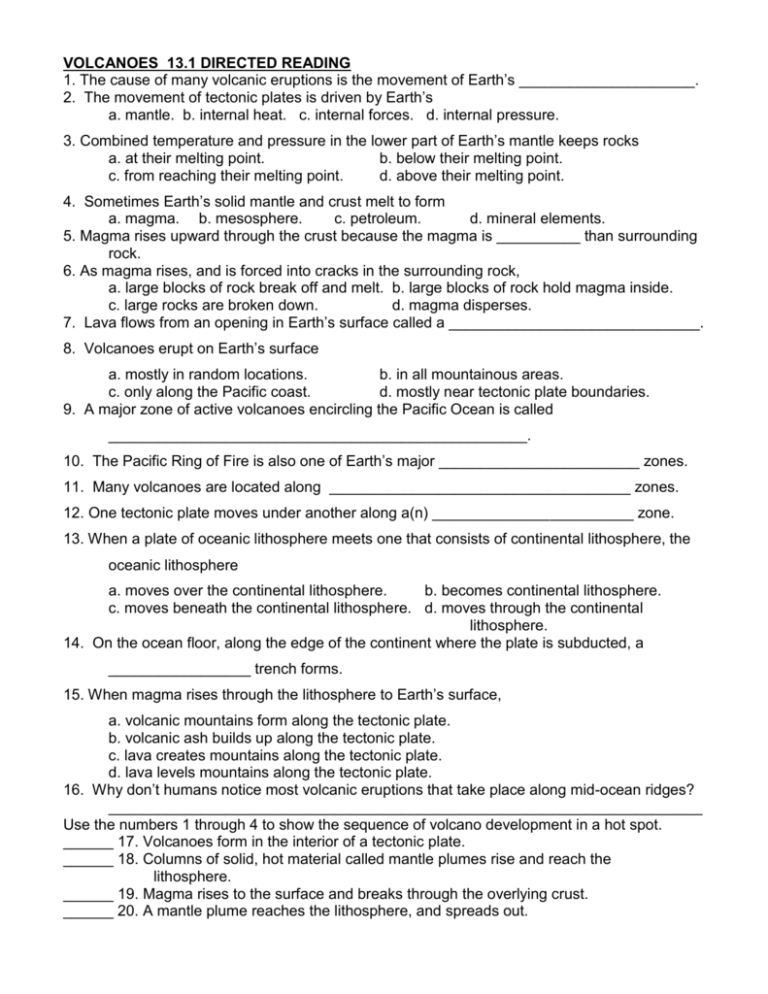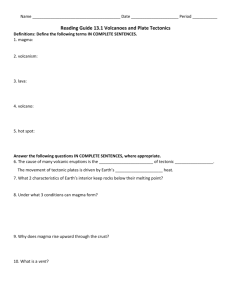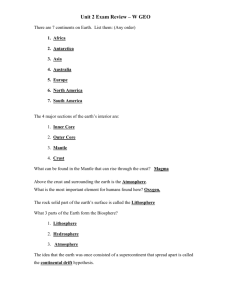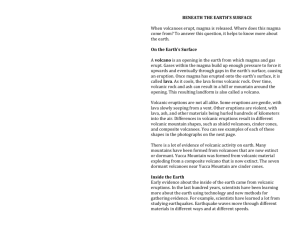Volcano Directed Reading
advertisement

VOLCANOES 13.1 DIRECTED READING 1. The cause of many volcanic eruptions is the movement of Earth’s _____________________. 2. The movement of tectonic plates is driven by Earth’s a. mantle. b. internal heat. c. internal forces. d. internal pressure. 3. Combined temperature and pressure in the lower part of Earth’s mantle keeps rocks a. at their melting point. b. below their melting point. c. from reaching their melting point. d. above their melting point. 4. Sometimes Earth’s solid mantle and crust melt to form a. magma. b. mesosphere. c. petroleum. d. mineral elements. 5. Magma rises upward through the crust because the magma is __________ than surrounding rock. 6. As magma rises, and is forced into cracks in the surrounding rock, a. large blocks of rock break off and melt. b. large blocks of rock hold magma inside. c. large rocks are broken down. d. magma disperses. 7. Lava flows from an opening in Earth’s surface called a ______________________________. 8. Volcanoes erupt on Earth’s surface a. mostly in random locations. b. in all mountainous areas. c. only along the Pacific coast. d. mostly near tectonic plate boundaries. 9. A major zone of active volcanoes encircling the Pacific Ocean is called __________________________________________________. 10. The Pacific Ring of Fire is also one of Earth’s major ________________________ zones. 11. Many volcanoes are located along ____________________________________ zones. 12. One tectonic plate moves under another along a(n) ________________________ zone. 13. When a plate of oceanic lithosphere meets one that consists of continental lithosphere, the oceanic lithosphere a. moves over the continental lithosphere. b. becomes continental lithosphere. c. moves beneath the continental lithosphere. d. moves through the continental lithosphere. 14. On the ocean floor, along the edge of the continent where the plate is subducted, a _________________ trench forms. 15. When magma rises through the lithosphere to Earth’s surface, a. volcanic mountains form along the tectonic plate. b. volcanic ash builds up along the tectonic plate. c. lava creates mountains along the tectonic plate. d. lava levels mountains along the tectonic plate. 16. Why don’t humans notice most volcanic eruptions that take place along mid-ocean ridges? _______________________________________________________________________ Use the numbers 1 through 4 to show the sequence of volcano development in a hot spot. ______ 17. Volcanoes form in the interior of a tectonic plate. ______ 18. Columns of solid, hot material called mantle plumes rise and reach the lithosphere. ______ 19. Magma rises to the surface and breaks through the overlying crust. ______ 20. A mantle plume reaches the lithosphere, and spreads out. 21. Describe what happens to volcanic activity when the lithospheric plate above a mantle plume continues to drift. _________________________________________________________ _________________________________________________________________________ 13. 2 DIRECTED READING 22. Lava provides an opportunity for scientists to study a. the nature of Earth’s inner core. b. the nature of Earth’s tectonic plates. c. temperatures within Earth. d. the nature of Earth’s crust and mantle. 23. By analyzing the composition of volcanic rocks, geologists have concluded that there a. is only one general type of magma. b. are two general types of magma. c. are three general types of magma. d. are two minerals in magma. 24. Magma or igneous rock that is rich in feldspar and silica and is generally light in color is called __________ . 25. Magma or igneous rock that is rich in magnesium and iron and is generally dark in color is called __________ . 26. Mafic rock commonly makes up a. oceanic crust. c. Earth’s inner core. b. continental crust. d. tectonic plates. 27. Felsic rock commonly makes up a. oceanic crust. c. Earth’s inner core. b. continental crust. d. tectonic plates. 28. The force of a volcanic eruption is affected by ___________________________________. 29. Mafic magmas, with low viscosity and runny lava, cause ___________________ eruptions. 30. Felsic magmas, with high viscosity and sticky lava, cause ___________________ eruptions. 31. Explosive eruptions are most likely to be caused by magma with ____________amounts of dissolved gases. 32. Eruptions from oceanic volcanoes are usually ______________________ eruptions. 33. volcanic cone 34. crater 35. shield volcano 36. cinder cone 37. composite volcano a. a volcanic cone that is broad at the base and has gently sloping sides b. structure formed by lava and pyroclastic material ejected during volcanic eruptions c. volcano with very steep slopes that are rarely more than a few hundred meters high and have angles close to 40° d. volcano made of alternating layers of hardened lava flows and pyroclastic material e. the funnel-shaped pit at the top of a volcanic vent 38. One of the most important warning signals of volcanic eruptions is a. a change in earthquake activity around the volcano. b. a change in air pressure around the volcano. c. a change in animal behavior around the volcano. d. increased steepness of the volcanic cone. 39. What are three causes of small earthquakes that could signal a volcanic eruption? a. ________________________________________________________________ b. ________________________________________________________________ c. ________________________________________________________________ 40. What are three comparisons scientists make between a volcano’s past behavior and its current behavior in order to help predict an eruption? a. ________________________________________________________________ b. ________________________________________________________________ c. ________________________________________________________________








